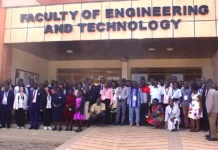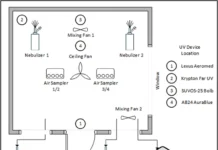By Troy Cowan, IUVA Healthcare/UV Working Group facilitator
As this edition of UV Solutions comes out, we’ll be about to open our second major event teamed with the National Institute of Standards and Technology (NIST), a new workshop entitled “Advancing UV Germicidal Efficacy Measurement: Metrology, Standards, Data and Protocols.” Set for March 18-20, this event’s purpose is to review our standards’ progress to date, present updates on the current state of Germicidal ultraviolet (GUV) radiation technology and then map out plans for tackling the remaining key issues that have vexed our industry for decades. These include the determination of the scientifically certifiable values for GUV inactivation doses for a given pathogen and an answer to how those values can be credibly, consistently and reliably derived in a commercial lab setting to measure efficacy performance of GUV devices.
Questions to be Answered
One might argue that these questions already have been answered for the water treatment industry, so what’s the problem? The problem is one of differences in complexity and definition. First, water treatment technologies have been well defined, with water quality standards clearly set by EPA and state regulators. This is not the case for GUV disinfection used to treat indoor air or surfaces. Specifically, there are no standards for how “clean” surfaces or indoor air should be after treatment. Water-borne pathogens of interest also are well known and have remained fairly consistent since first studied. Airborne and surfaceborne pathogens vary widely and evolve quickly (e.g., COVID-19).
Then, there’s the question of testing. The procedures for how samples are taken – and how many – is very different for water sampling, air sampling and surface sampling. Once the samples are obtained, how they’re processed in a lab can vary widely. Again, those procedures are fairly well defined for water, but not for air or surfaces, leading to wildly divergent results. Similarly, once the results are obtained, how are they reported to the user audience? That framework exists for water, but not so for the air or surface communities.
Workshop Focuses
These are serious questions to be answered, requiring significant thought and effort to respond. With this in mind, NIST and IUVA designed the workshop with the following features:
- keynote presentations from CDC and ASHRAE scoping the current situation;
- roundtable discussions between industry leaders on common goals and differing approaches, as well as assessments of various technology issues from the differing perspectives of industry, research and regulatory representatives;
- plenary sessions on current research topics, to include GUV inactivation behavior and UV air disinfection kinetics measurement, presented by IUVA and ASHRAE senior scientists;
- moderated panel sessions on global challenges related to microbiology measurement, as well as healthcare needs and pandemic response planning; and
- breakout working sessions to identify and define the issues, scope out plans and timelines for how the issues can be resolved, and assemble preliminary teams to execute the plans. These plans specifically will target air inactivation testing and acceptance, surface inactivation testing and acceptance, data quality requirements and reporting of test results, and microbiology laboratory testing.
Attendance is expected to include academic and industry SMEs, government research staff and senior policy makers, as well as senior representatives from the several associations that have contributed over the last six years to the fundamental and essential standards efforts that have formed the foundation for this workshop. Specifically, the following organizations should be acknowledged and thanked for their parts in making this possible:
- IES 1, for its efforts in promulgating multiple new and revised LM series of measurement standards, covering all types and configurations of GUV sources and luminaires, and developing them in record time, keeping pace with new technologies and sources;
- ASHRAE 2, for developing new standards for how to measure surface and air antimicrobial inactivation, in addition to making multiple revisions to related guidebooks and handbooks within ASHRAE’s inventory, and for hosting the 2023 Atlanta workshop;
- NEMA 3, for taking on the formidable task of developing a product description and labeling standard that will capture and present the results from the tests envisioned by the new measurement standards in a standardized and readily referenceable manner;
- HSI 4, for instituting the first-ever testing protocol for measuring surface disinfection efficacy in operating rooms and patient rooms, regardless of technology, that then assigns a “grade” to those results using a regimented rating system (also a first);
- NALMCO 5 and the University of Maryland School of Public Health, for developing the curriculum and training courses necessary to train and certify GUV technicians and designers in the design, installation and maintenance of GUV systems, once selected. All the performance standards in existence are meaningless unless the systems are designed, installed and maintained correctly.
- The Yale School of Medicine, for hosting the first 2018 IUVA Healthcare Workshop in 2018, which laid the framework for the good works that have followed since.
- NIST 6, in its support of the 2020 Workshop at NIST Gaithersburg, Maryland, and making available the opportunity to publish in the Journal of Research of NIST, as well as its support of the 2025 Workshop at the American Geophysical Union, Washington, D.C.
As we look ahead, the workshop has the potential to lead to the basis for building a credible and certifiable database of GUV inactivation values, a database that could be maintained by a federal agency to ensure objectivity and provide good security and change control. Such a referenceable database, in combination with other product-specific testing data, could form the basis for certification of tested machines as capable of inactivating pathogens of choice under specified conditions, based on the tests performed and the certified results. Being able to use certified, pathogen-specific data in product advertising would save manufacturers the cost of performing lab tests, as currently required to make such claims.
Conclusion
As readers can see, these essential testing and measurement methodologies have been developed as a prologue to this moment, making this next advancement in GUV efficacy/performance standards possible. But, this leads to an existential question for the GUV industry: Does the industry invest the resources and efforts necessary over the next two to three years to execute the proposed plans for air, surface, data and laboratory to produce these critical performance-measuring tools or do these efforts stall while waiting the five to 10 years that it may take the regulatory system to define these standards for the GUV industry and then mandate compliance?
The fundamental choice is one of time. How many more pandemics will occur as the industry waits? How many more MDROs will make the news? It’s all about saving lives… What’s your choice?
References
- Illuminating Engineering Society (IES), working on various standards to include IES/LM-91 through LM-95 and an update to CIE 220-2016
- Society of Heating, Refrigerating, & Air-Conditioning Engineers (ASHRAE), working on various standards to include ASHRAE Standards 185.1-185.5P. ASHRAE Handbook (Chapters 17 & 62), GPC-37 and ASHRAE 241
- National Electrical Manufacturers Association (NEMA) working on ANSI C137.12-202X
- Healthcare Standards Institute (HSI), working on ANSI/HSI 2000-2023
- interNational Association of Lighting Management Companies (NALMCO), working on GUV Training and Certification, with IUVA, IES and the University of Maryland School of Public Health
- NIST Workshop on Ultraviolet (UV) disinfection technologies, January 14-15, 2020, with publication of the Journal of Research of NIST, Volume 126, Special Section on Ultraviolet Technologies for Public Health, which can be found at https://www.nist.gov/news-events/events/2025/03/advancing-uv-germicidal-efficacy-measurement-metrology-standards-data-and






